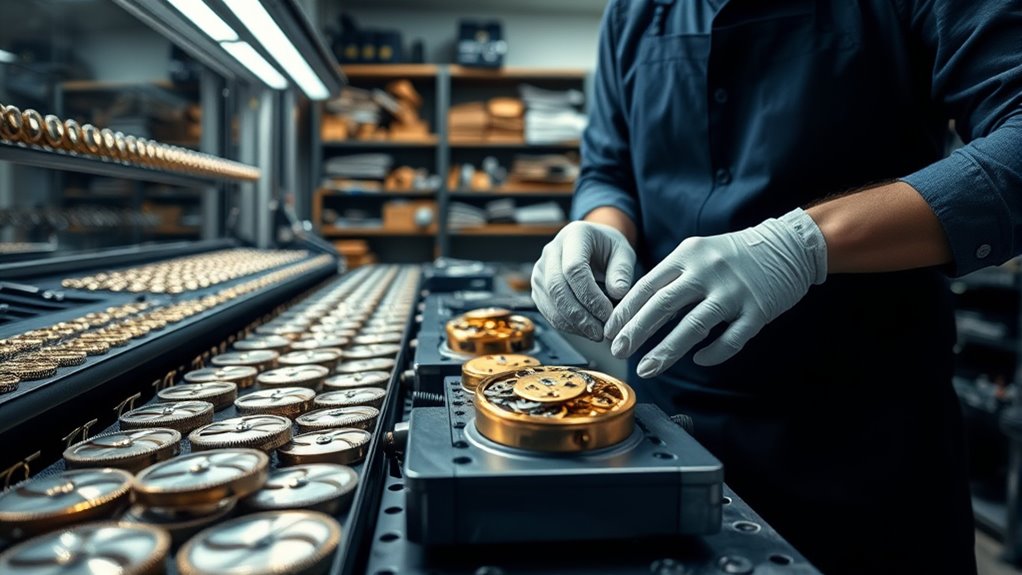Inside a Swiss watch factory, you’ll see master watchmakers skillfully blending traditional craftsmanship with precise engineering. They meticulously assemble tiny components, polish surfaces, and use modern innovations like laser etching to enhance quality. Every piece is inspected carefully to guarantee flawless performance and timeless beauty. This delicate process combines artistry and technical mastery, creating watches that are more than just timepieces—they’re miniature masterpieces. Continue exploring to discover how these expert techniques keep Swiss watchmaking world-renowned.
Key Takeaways
- Swiss watch factories combine traditional craftsmanship with modern technology to ensure precise, reliable timekeeping.
- Skilled artisans meticulously assemble tiny components using specialized tools and techniques.
- Inspection and finishing processes, like polishing and laser etching, enhance both aesthetics and functionality.
- Innovations such as laser engraving complement traditional hand-finishing for detailed craftsmanship.
- The art of Swiss watchmaking emphasizes quality, precision, and the preservation of a rich horological heritage.

Watchmaking is a precise blend of craftsmanship and engineering, where every tiny component must fit perfectly to keep time accurately. As you step into a Swiss watch factory, you immediately sense the meticulous attention to detail that goes into every stage of creation. Mechanical precision lies at the heart of watchmaking, demanding that each gear, spring, and wheel is crafted with exact measurements and flawless execution. You realize that precision isn’t just about accuracy; it’s about ensuring the entire movement functions seamlessly over decades. The artisans here employ a variety of craftsmanship techniques to achieve this level of perfection, from traditional hand-finishing to cutting-edge machinery. These techniques help shape and assemble components that are often smaller than a grain of sand, requiring steady hands and unwavering focus.
Watchmaking combines craftsmanship and engineering to create precise, seamless, and timeless mechanical masterpieces.
You watch as skilled watchmakers use loupe magnifiers to inspect each part. They employ craftsmanship techniques like polishing, angling, and brushing, which not only enhance the watch’s aesthetic appeal but also serve functional purposes—reducing friction, preventing corrosion, and ensuring smooth operation. These techniques are rooted in centuries-old traditions, yet they are continually refined with modern innovations. For example, hand-polishing adds a unique luster to bridges and rotors, while laser etching allows for precise engravings without damaging delicate parts. Every step is deliberate, emphasizing the importance of craftsmanship techniques that elevate a watch from mere machinery to a work of art. Additionally, understanding the local laws relevant to watchmaking can influence quality standards and certification processes.
You notice that assembling the movement is a delicate process. Watchmakers use tweezers and specialized tools to place each tiny component. Their steady hands and impeccable craftsmanship ensure that the mechanical precision remains unblemished. This meticulous process guarantees that the watch’s gears, escapements, and springs work in perfect harmony, maintaining accurate time. You get a sense of the patience and skill involved—each component must be aligned perfectly, with no room for error. This is where craftsmanship techniques shine, as they bridge the gap between mechanical engineering and artistic mastery. It’s not just about function; it’s about creating a masterpiece of miniaturized engineering that embodies tradition, precision, and innovation.
In this environment, you see that the art of watchmaking isn’t just about producing a timepiece; it’s about preserving a legacy of craftsmanship and technological mastery. Every movement, every component, reflects a commitment to excellence that has been refined over generations. As you leave, you carry an appreciation for how these tiny masterpieces are brought to life through a combination of mechanical precision and expert craftsmanship techniques—truly, the pinnacle of horological artistry.
Frequently Asked Questions
How Long Does It Take to Produce a Single Swiss Watch?
You might wonder how long it takes to produce a Swiss watch, and it typically spans several months. This meticulous process guarantees luxury branding standards are met, emphasizing craftsmanship and precision. Throughout production, customer service remains a priority, providing updates and reassurance. Every component is carefully assembled and tested, reflecting the dedication behind each timepiece. Your patience pays off when you receive a finely crafted watch that embodies quality and exclusivity.
What Materials Are Primarily Used in High-End Swiss Watches?
Imagine a master chef selecting only the finest ingredients—that’s how you should view high-end Swiss watches’ materials. They primarily use luxury materials like 18k gold, platinum, and high-grade stainless steel, carefully sourced for quality and durability. These materials are the foundation of a watch’s elegance and precision, showcasing the meticulous material sourcing that guarantees each timepiece stands the test of time and embodies true craftsmanship.
How Do Watchmakers Ensure Precision and Accuracy?
You guarantee precision and accuracy by employing meticulous craftsmanship techniques and rigorous quality control processes. You carefully assemble each component, often using specialized tools, to maintain tight tolerances. Regular inspections and testing verify that each watch meets strict standards. By paying attention to detail and continuously monitoring performance, you assure that every watch delivers exceptional accuracy and reliability, reflecting the skill and dedication built into Swiss watchmaking traditions.
Are There Any Modern Technologies Integrated Into Traditional Watchmaking?
Think of traditional watchmaking as a finely woven tapestry, now enhanced with digital innovation. You’ll find smart manufacturing techniques integrated into the process, such as CNC machines and laser welding, which boost precision and efficiency. These modern technologies blend seamlessly with classic craftsmanship, ensuring each watch remains a masterpiece. Embracing digital innovation allows you to enjoy the timeless art of watchmaking while benefiting from cutting-edge advancements that elevate quality and consistency.
What Are the Most Common Challenges Faced in Swiss Watch Manufacturing?
You face common challenges like supply chain disruptions, which delay components and production timelines, and skilled labor shortages, making it harder to uphold craftsmanship standards. These issues push you to find reliable suppliers and invest in training your workforce. Balancing tradition with modern demands becomes tricky, but by addressing these hurdles proactively, you guarantee the quality and precision Swiss watchmaking is renowned for remain intact.
Conclusion
As you’ve seen, Swiss watchmaking combines precision craftsmanship with centuries of tradition. Did you know that over 80% of the world’s luxury watches are made in Switzerland? This dedication to quality guarantees each watch isn’t just a timepiece but a piece of art. So, next time you admire a Swiss watch, remember the intricate process and passion behind every tiny gear. It’s truly a marvel of craftsmanship you can wear every day.










